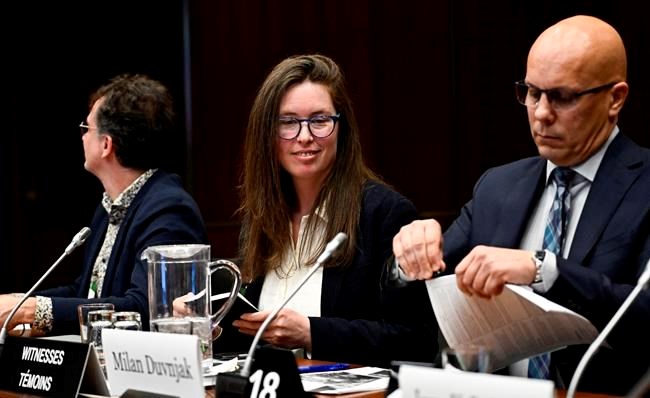OTTAWA — Nearly a year after Health Canada issued a draft recommendation to designate an entire class of chemicals as toxic, environmental experts say it's time to actually do something about it.
There are now more than 10,000 variations of per- and polyfluoroalkyl substances, which are used in hundreds of products from waterproof cosmetics and stain repellents to carpeting and non-stick cookware.
Scientifically they are referred to by the acronym PFAS, pronounced like Pea-fass. But many call them "forever chemicals" because they don't break down.
Cassie Barker, the toxics program manager at Environmental Defence, told the House of Commons environment committee Thursday that the chemicals have one of the strongest bonds in organic chemistry, making it nearly impossible for them to break down.
"Instead they persist forever and accumulate in the environment and our bodies for years," Barker said.
Studies have linked them to significant health problems including cancers, hormone disruptions, immune system problems and liver disease.
In May 2023 Health Canada issued a draft recommendation, following a scientific review of available evidence, that said the science meets the requirement to label PFAS as toxic under the Canadian Environmental Protection Act.
That designation would then allow regulation of the substances, including an outright ban.
Barker said not only is it time to move to finalize that designation, the regulations must swiftly follow. She said the important thing is to designate the entire class, not just each substance individually.
Canada did designate and ban some versions of PFAS in 2012 but other products simply moved in to take their place and pose similar harm, said Barker. This time, the proposal is to label the full class at the same time.
"We can't just keep playing whack-a-mole here," Barker said.
In a statement, Environment and Climate Change Canada said a final report deciding whether to confirm the toxic designation is expected "in the coming months." If the designation goes ahead, a risk management plan will be published at the same time.
The European Union and several U.S. states have already moved to limit or phase out their use. Europe is phasing out all PFAS except for essential uses where there is no alternative.
California has put limits on the use of the chemicals in food packaging, banned them entirely in products aimed at children under the age of 12 and will ban all PFAS from cosmetics next year.
Last June 3M agreed to settle lawsuits from more than 300 municipalities who found the chemicals in their drinking water. The settlement could reach more than $12.5 billion. The company is also planning to stop making PFAS by 2025.
In 2005, DuPont was fined US$16.5 million by the U.S. Environmental Protection Agency for failing to report its research that had found potential health risks to PFAS chemicals it made as early as 1981.
The chemicals were unregulated at that point. DuPont also paid more than US$107 million to settle a water-contamination lawsuit by residents who lived near the West Virginia plant.
In Canada, most consumers are currently not even informed if the product they're buying contains forever chemicals, Barker said.
Sébastien Sauvé, a professor of environmental chemistry at the University of Montreal, told the committee he collected nearly 500 drinking water samples in Quebec from 376 different municipalities. All but two contained at least some traces of PFAS.
Health Canada proposed new limits for PFAS in drinking water in February 2023.
"But we're one year later and these recommendations have still not been adopted through our comments, but we're still waiting to see any results," said Sauvé.
Barker said even if there are limits placed on PFAS in drinking water, municipalities are at a loss about how to comply. The technology that would at least capture most of the chemicals is extremely expensive, she said, and municipalities have no power to keep them from entering their waterways in the first place.
Last June, in a letter to Environment and Climate Change Canada responding to the draft toxic designation, the Chemistry Industry Association of Canada asked that PFAS not be designated toxic as an entire class of substances but on a case-by-case basis, based on proven risk.
"These substances impart a wide range of important performance characteristics that are vital for industrial safety and the manufacture and performance of medical devices, cellphones and laptops, telecommunications infrastructure and advanced transportation, aerospace, and defence applications, among many others," the industry wrote.
"Moreover, PFAS currently used by Canadian industry have not been shown to be of high risk."
The association warned that following Europe's lead and widely regulating the category would be a mistake.
"Canada should not follow the example of other jurisdictions, who have proposed sweeping prohibitions of this class of substance and who will likely face economic hardship and significant consequences to a variety of value chains, requiring correction after the fact," the letter said.
This report by The Canadian Press was first published March 22, 2024.
Mia Rabson, The Canadian Press



